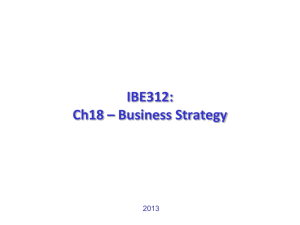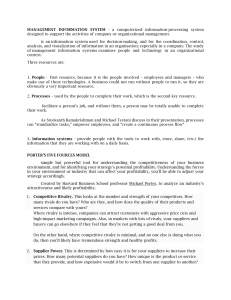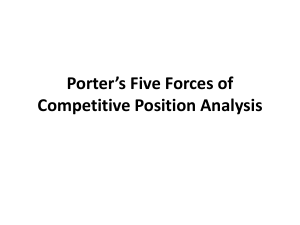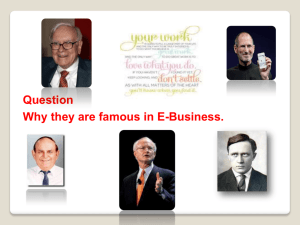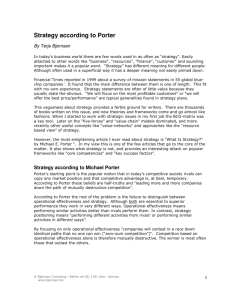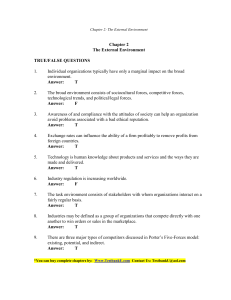Pertemuan 25 • Materi : Buku Wajib & Sumber Materi :
advertisement
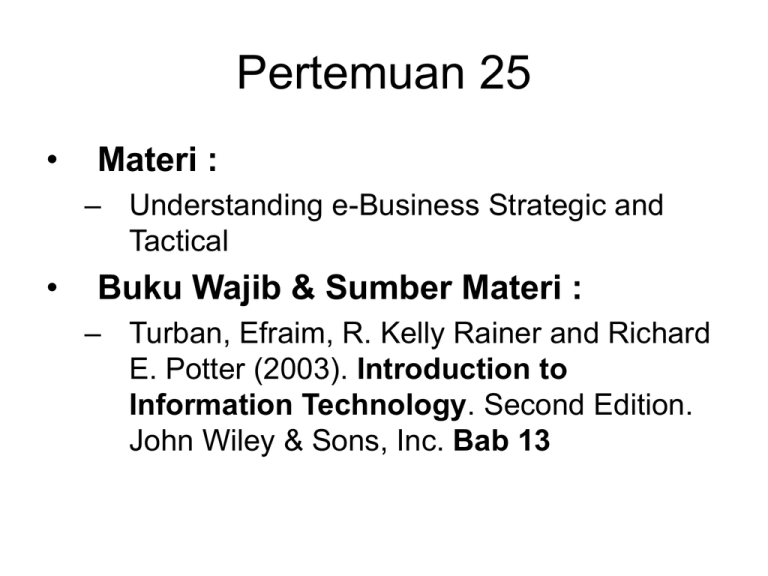
Pertemuan 25 • Materi : – Understanding e-Business Strategic and Tactical • Buku Wajib & Sumber Materi : – Turban, Efraim, R. Kelly Rainer and Richard E. Potter (2003). Introduction to Information Technology. Second Edition. John Wiley & Sons, Inc. Bab 13 Strategic Information Systems • Strategic Information Systems : systems that support or shape an organization’s competitive strategy • May significantly change the way the business operates • Makes substantial contribution toward achieving strategic goals • May increase performance and productivity significantly Strategic Information Systems • Outward focus: aimed at direct competition in an industry • Inward focus: enhance the competitive position of the firm through… – Increasing employee productivity – Improving teamwork – Enhancing communication • Strategic Alliances : two or more companies share an inter-organizational system for mutual benefit Competitive Strategy & IT • Strategy is the creation of a unique and valuable position, involving a set of activities different than what rivals do • IT creates competitive advantage by giving companies new ways to outperform their rivals – – – – Create new applications Enable reengineering of business processes Enable innovation Provide competitive intelligence Competitive Intelligence on the Internet Intelligence Search Strategy Review competitor’s Web sites Analyse related newsgroups Examine publicly available financial documents Description Reveal information about marketing information Find out what people think about a company and its products By entering a number of databases and analyse findings Do market research at your own Web site Pose questions to Web site visitors Use an information delivery service to gather news on competitors Find what is published on the Internet about competitors Use corporate research companies Provide information ranging from risk analysis to stock market analysts’ reports about competitors Porter’s Competitive Forces Model and IT • Porter’s Competitive Forces Model – Competition - at the core of a firm’s success or failure – Used to develop strategies for companies to increase their competitive edge – Demonstrates how IT can enhance the competitiveness of corporations – 5 major forces: Threat of entry of new competitors Threat of substitute products or services Bargaining power of suppliers Bargaining power of customers (buyers) Rivalry among existing firms in the industry Porter’s Five Forces Model Porter’s Competitive Forces Model and IT • Response Strategies (Per Porter and Others) – may be supported in part by IT – Cost leadership strategy - producing at lowest cost – Differentiation strategy - being unique – Focus strategy - selecting a narrow-scope segment – Growth strategy - increasing market share – Alliances strategy - working with business partners – Innovation strategy - developing new products – Internal efficiency strategy - improving the manner in which business processes are executed – Customer-oriented strategy - concentrating on making customers happy Impact of IT on Competitive Forces Key Forces Affecting Business the Industry Implications Threat of new • Additional capacity entrants • Reduced prices • New basis for competition High power suppliers High power buyers • Raise prices/costs • Reduce quality of supply • Reduce availability • Forces prices down • Higher quality demanded • Service flexibility required • Encourage competition Potential IT Responses • Exploit existing economies of scale • Differentiate products / services, • Control distribution channels • Segment markets • Implement sourcing systems • Extend quality control into suppliers’ operations • Use forward planning with suppliers • Differentiate and improve products/ services • Increase switching costs of buyers • Facilitate buyers product selection Impact of IT on Competitive Forces Key Forces Affecting the Industry Business Implications Substitute products threatened • Limits potential and profit • Imposes price ceilings Intense competition from rivals • Price competition • Need to develop new products and services • Distribution and service become critical • Customer loyalty required Potential IT Responses • Use differentiation strategy • Incorporate IT into product, service, or method of provision • Improve price/performance • Redefine products and services to increase value • Redefine market segments • Differentiate products and services in distribution channels and to consumers • Get closer to the end consumer - understand the user requirements The Need for Organizational Change • Organizational structures and processes established in the Industrial Revolution are no longer effective, due to… – – – – Globalization Pressure for rapid change Increasingly demanding customers Opportunities afforded by IT • Focus on vertical, functional organization is inappropriate • Need integration that spans departmental and organizational boundaries Business Process Reengineering • Solution based on fundamental rethinking and radical redesign of business processes to achieve dramatic improvements in measures of performance • Elements: – – – – – Job Enrichment Employee Empowerment Process Simplification Mass Customization Reduced Cycle Time Changes in Work Rules Brought by IT Old Rule Intervening Technology New Rule Information appears in only one place at one time Shared databases, client/server architecture, electronic mail Information appears simultaneously wherever needed Only an expert can perform complex work. Expert systems, neural computing Novices can perform complex work. Managers make all decisions. Decision support systems, enterprise support systems, expert systems Decision making is part of everyone’s job Field personnel need offices to receive, send, store, and process information. Wireless communication and portable computers, information highways, electronic mail You have to locate items manually. Tracking technology, groupware, workflow software, client/server Items are located automatically Plans get revised periodically. High-performance computing systems Plans get revised instantaneously whenever needed. Field personnel can manage information from any location. Changes in Work Rules Brought by IT Old Rule Intervening Technology New Rule People must come to one place to work together. Groupware and group support systems, telecommunication, electronic mail, client/server People can work together from different locations. Customized products and services are expensive and take a long time to develop. CAD-CAM, CASE tools, online systems for JIT decision making, expert systems Customized products can be made fast and inexpensively (mass customization). A long period of time is spanned between the inception of an idea and its implementation (time to market) CAD-CAM, electronic data interchange, groupware, imaging (document) processing Time-to-market can be reduced by 90 percent Work should be moved to countries where labor is inexpensive (off-shore production). Robots, imaging technologies, object-oriented programming, expert systems Work can be also done in countries with high wages and salaries. Networked Organization • Resemble computer networks and are supported by computerized systems • Shift toward the networked organization due to the movement toward an information-based economy Hierarchical Organization Formal Highly structured Manage Control Direct Employees a cost Information management-owned Hierarchical organizations Risk avoidance Individual contributions Networked Organization Informal Loosely structured Delegate/lead Ownership/participation Empower Employees an asset Information shared ownership Flatter/ manageable organizations Risk management Team contributions Virtual Corporations • Characteristics of Virtual Corporations (VC) – Excellence - each partner brings its core competence so an – – – – – – all-star winning team is created. No single company can match what the virtual corporation can achieve. Full utilization of resources - some resources of the business partners may be underutilized when not in a VC. Opportunism - the partnership is opportunistic. A VC is organized to seize market opportunities. Lack of borders - it redefines traditional boundaries. Trust - business partners in a VC are far more reliant on each other and more trusting than ever before. Adaptability to change - the VC can quickly adapt to environmental changes because its structure is relatively simple. Technology - IT makes the VC effective and efficient.
